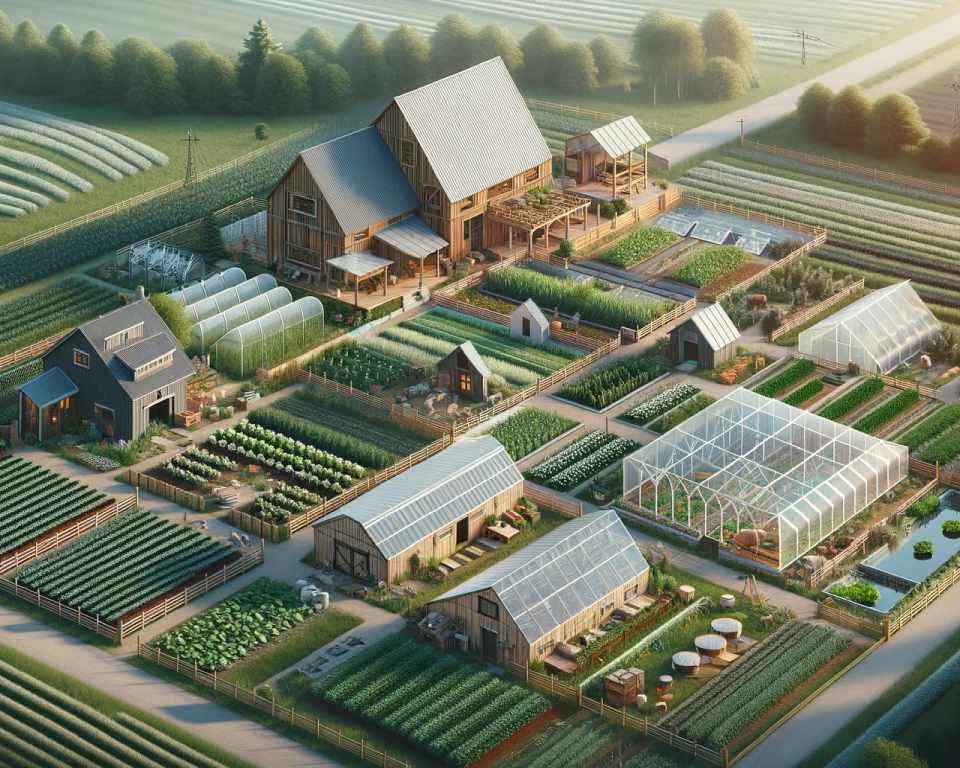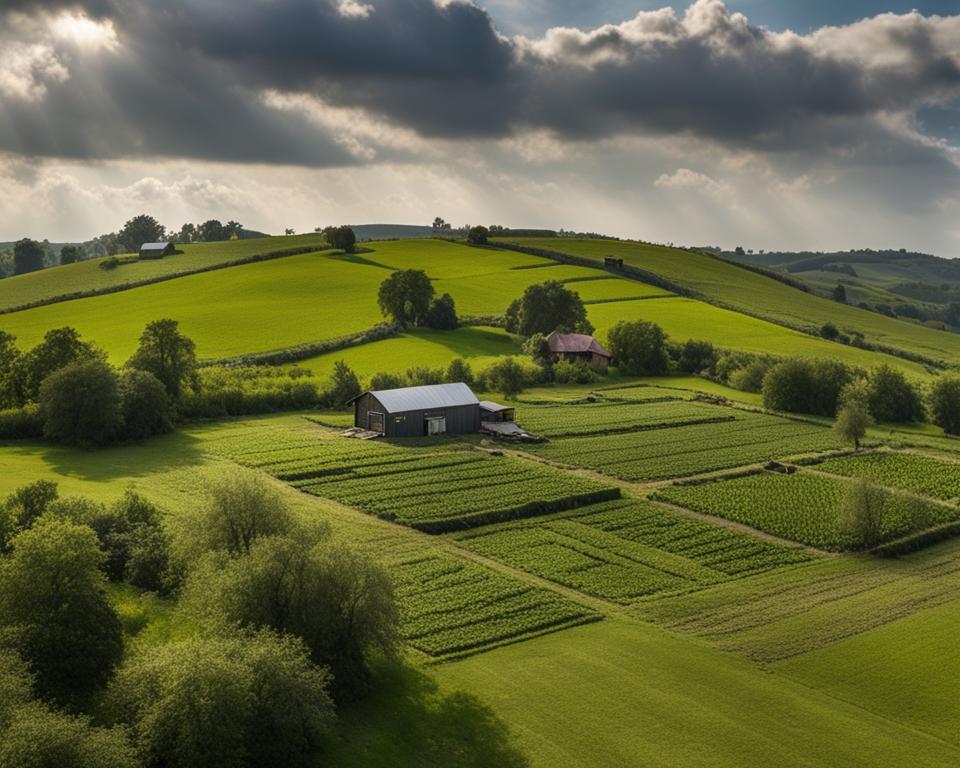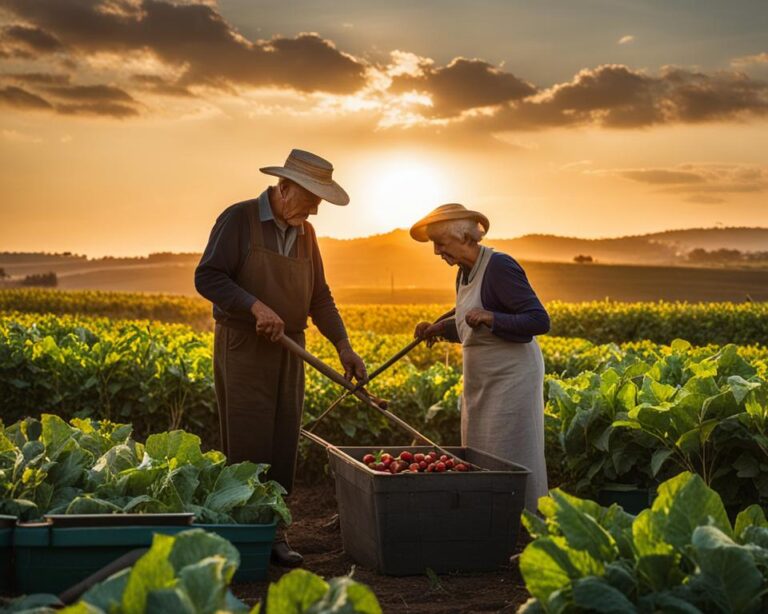The Acreage Question: How Much Land Do You Need for Homesteading?
Welcome to our comprehensive guide on homesteading land requirements. If you’re considering embarking on a homesteading journey, one of the most critical decisions you’ll face is determining how much land you’ll need. In this article, we’ll explore the factors that influence homesteading land size and provide you with valuable tips to help you make an informed decision.
Homesteading can be accomplished on a range of acreages, depending on factors such as your vision, desired level of self-sufficiency, and the nature of the terrain. For those with limited space, small acreages of 2-4 acres can sustain a small family with careful management. On the other hand, larger homesteads ranging from 20-40 acres offer greater opportunities for woodlots, orchards, and livestock.
As you embark on your homesteading journey, it’s crucial to consider the various aspects that influence the size of land you’ll require. From evaluating soil characteristics and water availability to assessing infrastructure and facilities and considering proximity to markets and amenities, each factor plays a vital role in determining your homestead’s success.
Stay with us as we delve into the details of acquiring homesteading land in section two and explore the qualifications and criteria you should keep in mind throughout your search. We’ll also provide valuable tips to help you evaluate your acreage needs effectively. Let’s dive in!
Tips for Buying Homesteading Land
When acquiring homesteading land, there are several important factors to consider to ensure your purchase meets the legal requirements and zoning regulations necessary for homesteading success. We’ve compiled a list of tips to guide you through the process.
- Remoteness: Consider the level of remoteness that suits your lifestyle. Some homesteaders thrive in secluded areas, while others prefer closer proximity to towns or cities for amenities and social interactions.
- Community: Look for a community of like-minded individuals who share your homesteading aspirations. Connecting with others who have similar goals can provide valuable support and resources.
- Distance from Neighbors and Medical Care: Evaluate the distance to neighboring properties and access to medical care. Consider how far you are willing to travel in case of emergencies and the level of privacy you desire.
- Access to Phone and Internet: Reliable phone and internet connectivity are crucial for staying connected with the outside world, accessing resources, and running your homestead efficiently.
- Land Characteristics: Assess the quality and suitability of the land for your specific homesteading needs. Factors such as soil fertility, topography, and availability of water sources are important considerations.
- Restrictions or Covenants: Be aware of any restrictions or covenants that may limit the activities you can undertake on the property. These may include prohibitions on certain building structures or limitations on livestock or agriculture.
- Signs of Contamination or Flooding: Conduct thorough inspections to identify any signs of contamination or potential flooding risks. This is essential for the safety of your family, livestock, and crops.
- Availability of South-Facing Land for Gardening: South-facing land receives the maximum sunlight, which is essential for successful gardening. Consider the availability of such land for your vegetable and fruit gardens.
- Soil Quality: Assess the soil quality and composition to ensure it is suitable for the crops and plants you wish to cultivate. Consider consulting a soil scientist or conducting soil tests for accurate analysis.
- Availability of Clear Land for an Orchard: If you plan to have an orchard, ensure there is sufficient clear land available for planting and maintaining fruit trees.

- Access to Wood for Heating and Construction: If you rely on wood for heating or construction purposes, ensure there is a sustainable source of wood on the property or nearby.
- Access to Fertilizer: Evaluate the availability and proximity of fertilizer sources to support your farming or gardening endeavors.
- Suitability for Livestock: If keeping livestock is part of your homesteading plan, consider the suitability of the land for grazing, shelter, and other livestock-related activities.
- Potential for Alternate Energy Systems: Explore the potential for implementing alternate energy systems such as solar panels or wind turbines to reduce your reliance on traditional energy sources.
- Access to Municipal Services: Determine if the property has access to essential municipal services such as water, sewer, and waste disposal. This can significantly impact the convenience and practicality of your homesteading lifestyle.
- Natural Disaster Potential: Research the area’s susceptibility to natural disasters like hurricanes, floods, wildfires, or earthquakes. Take necessary precautions and consider the property’s ability to withstand such events.
- Adjacent Properties: Examine neighboring properties to understand their potential impact on your homesteading activities. Consider factors such as land use, noise levels, and compatibility with your goals.
By carefully considering these tips and conducting thorough research, you can make an informed decision when acquiring homesteading land that aligns with your vision and meets the necessary legal requirements and zoning regulations.
Evaluating Acreage Needs for Homesteading
To determine how much land you need for homesteading, it’s essential to consider the purposes the land will serve. We’ll discuss various factors that influence the acreage requirements for different homesteading activities.
Fruit and Vegetable Gardens:
An average fruit and vegetable garden for family use typically requires 0.25 to 1 acre, depending on the size of your family and the types of crops you want to grow. Keep in mind that some crops, such as corn or potatoes, require more space than others like lettuce or herbs.
Raising Livestock:
If you plan on raising animals for meat or dairy, the required acreage will depend on the specific animal and the quality of available forage. For instance, cows typically require around 2 acres of quality forage per animal. Assess the number of animals you want to raise and calculate the acreage accordingly.
Woodlot:
If you rely on wood for heating or construction, you’ll need to allocate space for a woodlot. The size of the woodlot will depend on your heating needs and the availability of suitable wood on your property.
Deer Hunting:
If hunting is an important aspect of your homesteading lifestyle, you’ll want to consider the acreage needed for deer hunting. This will largely depend on the local deer population, hunting regulations, and your individual hunting preferences.
Farm Structures:
Finally, don’t forget to account for the space required for farm structures, such as barns, sheds, or greenhouses. The size and number of structures will depend on the specific needs of your homesteading activities.
When determining your acreage needs, it’s crucial to conduct careful analysis, research, and planning. Consider consulting with local agricultural extension offices or experienced homesteaders to gain insights into the specific acreage requirements for your desired activities.

Homesteading Permits and Land Qualifications
It’s important to note that homesteading land qualifications and requirements may vary depending on your location. Before purchasing or investing in land, familiarize yourself with any relevant permits or zoning regulations in your area. Local government offices, such as the county planning department or the Department of Agriculture, can provide valuable information on land criteria and permit procedures.
By evaluating the acreage needs for your specific homesteading activities and understanding the necessary permits and qualifications, you can make informed decisions when selecting land for your homestead. Remember, careful planning and research are vital to ensure the success of your homesteading journey.
Assessing Soil Characteristics for Homesteading
When it comes to homesteading, assessing soil characteristics is essential for successful land use. Factors such as soil depth, texture, and organic content determine the suitability of your land for various activities like growing crops, installing septic systems, and building foundations.
To get a comprehensive evaluation of your soil, you have a couple of options. You can consult the USDA Soils Map, a valuable resource that provides information about soil types and properties in your area. Additionally, hiring a qualified soil scientist can provide you with a thorough assessment of your property’s soil quality and composition.
It’s important to consider topography when evaluating soil characteristics. Flat and open spaces are generally easier to work with, providing convenience and efficiency for various homesteading activities. If you plan to convert woodland into cropland or pasture, remember that additional costs may be involved, such as stump removal, grading, and erosion control.
“Soil characteristics are a vital consideration for homesteading because they directly impact your ability to grow crops, manage waste effectively, and establish a solid foundation for your infrastructure. Assessing your soil’s properties will help you make informed decisions and optimize your land use.”
In summary, understanding your soil’s characteristics is crucial for homesteading success. By assessing factors like soil depth, texture, and organic content, you can determine the suitability of your land for different activities. Consult resources like the USDA Soils Map or hire a soil scientist, and take topography into account when planning your homestead. With this knowledge, you can make informed choices and optimize your land use for a thriving homesteading lifestyle.
Considering Water Availability for Homesteading
Access to clean water year-round is essential for homesteading. Without an adequate water source, it would be challenging to sustain your homestead and meet both personal and agricultural needs. When evaluating potential homesteading land, it is crucial to assess the quality and quantity of water available on the property.
There are various options to consider when it comes to accessing water for your homestead. These include ponds, streams, wells, and even municipal sources for those located closer to urban areas. Each option has its own advantages and considerations, so it’s important to carefully weigh the pros and cons.
Before making a decision, it’s essential to consider the mechanics of moving water on the property and the potential costs involved in installation. Factors such as pond surface area, depth, and weed presence should be taken into account. Stream flow can vary significantly throughout the year, so it’s important to assess its consistency and reliability. If considering a well, it should be tested for depth and flow rate to ensure it meets your needs.
While municipal water sources generally offer high water quality, it is important to consider the cost per unit. Depending on your location and usage, this cost can add up over time. Evaluating the financial aspect alongside your specific requirements will help you make an informed decision.

If you are unsure about the water availability of a property, it may be beneficial to consult with experts or professionals who can provide insight into the local water sources and any related homesteading regulations.
“Water is a precious resource that forms the backbone of any successful homestead. It serves not only as a vital element for personal use but also as a lifeline for crops, animals, and various homesteading activities. Carefully considering water availability is a crucial step in creating a self-sustaining homestead.”
Infrastructure and Facilities for Homesteading
When searching for the perfect homesteading property, it’s essential to consider the existing infrastructure and facilities on the land. These factors can greatly impact the property’s suitability for successful homesteading. Here are some important aspects to evaluate:
1. Existing Infrastructure
An ideal homesteading property should have existing infrastructure such as fencing, sheds, and barns. These structures can save you time, effort, and money by providing spaces for livestock, storing equipment, and protecting your crops. However, it’s crucial to assess the quality, condition, and suitability of the existing infrastructure. Outdated or dilapidated structures may require extensive repairs or replacements, which can add to the overall cost of the property.
2. Access to Utilities
Access to essential utilities is another crucial consideration when evaluating a homesteading property. Ensure that the land has reliable access to electricity, water, sewer, cell service, and internet. These utilities are necessary for daily living, running essential equipment, and staying connected with the outside world. Lack of access to utilities can pose significant challenges and impact the overall feasibility of your homesteading venture.
3. Property Boundaries and Legal Descriptions
Purchasing a property with well-marked boundaries and accurate legal descriptions is vital. Clearly defined boundaries not only provide clarity on property ownership but also help prevent any potential boundary disputes with neighboring landowners. Accurate legal descriptions ensure that you understand the exact dimensions and characteristics of the land you are acquiring, enabling better planning and utilization.
4. Utility Installation Costs
Before finalizing the purchase of a homesteading property, it’s essential to consider the cost of installing necessary utilities if they are not readily available. Utility installation expenses can vary significantly depending on factors such as proximity to existing infrastructure, terrain, and local regulations. It’s important to factor in these costs when determining the overall affordability and feasibility of the property.
In summary, evaluating the infrastructure and facilities of a potential homesteading property is crucial for a successful venture. Existing infrastructure, access to utilities, accurate legal descriptions, and installation costs should all be carefully considered. Taking these factors into account will help you make an informed decision and find a property that meets your homesteading needs.
Dealing with Trash and Contamination for Homesteading
When considering a rural parcel for your homestead, it’s crucial to address potential issues such as trash, contamination, and hazardous materials. These concerns can arise from various sources, including abandoned vehicles, old buildings, and debris piles. To ensure the safety of your family and the sustainability of your homesteading venture, we recommend taking the following steps:
Thorough Research and Evaluation
Conduct comprehensive research into the property’s past uses and history. This information can provide valuable insights into any potential contamination or environmental hazards that may exist. Additionally, professional evaluation or site audits are highly recommended to identify possible risks and determine appropriate remediation measures.
Insurance Coverage
Consider securing appropriate insurance coverage to protect yourself against potential liabilities associated with contamination or hazardous materials. Consult with insurance providers who specialize in environmental policies to find the most suitable coverage for your homesteading land.
All-Season Property Inspection
Inspect the property during different seasons to identify any hidden issues. This practice will help you uncover any potential problems that may be more apparent during certain times of the year, such as erosion, flooding, or the presence of harmful substances.
Taking proactive measures to address trash and contamination on your homesteading land is vital for the health and safety of your family, the environment, and the long-term success of your homesteading endeavor.
By addressing these concerns early on, you can create a safe and sustainable environment that aligns with your homesteading goals and values.

Proximity to Markets and Amenities for Homesteading
When considering a property for your homesteading venture, it’s crucial to take into account its proximity to various amenities and markets. While the allure of rural seclusion may be appealing, easy access to essential services is equally important for a successful and convenient homesteading experience.
First and foremost, evaluate the property’s distance from schools and medical care facilities. If you have children or anticipate the need for medical attention, having these amenities within a reasonable distance can provide peace of mind and save valuable time in emergencies.
Another key consideration is the property’s proximity to shopping options. While homesteading encourages self-sufficiency, there will still be occasions when you need to stock up on supplies or purchase tools and equipment. Having convenience stores, supermarkets, or farm supply retailers nearby can make your day-to-day tasks more manageable.
Creating a balance between seclusion and access to markets is essential. While remote locations offer tranquility and breathtaking landscapes, being too far away from markets can make it challenging to sell your products or acquire necessary materials. It’s important to find a middle ground that allows you to enjoy the benefits of an idyllic countryside setting while also having convenient access to markets and potential customers.
Quote:
“Finding a homestead location with the right balance of isolation and proximity to markets is a key consideration. You want to enjoy the peace and serenity of a rural lifestyle while still being able to easily connect with the larger community and access the amenities you need.” – David Anderson, Homesteading Expert
To ensure a smooth homesteading journey, thoroughly assess the proximity of potential properties to markets, schools, medical care, and shopping facilities. By striking the right balance, you can enjoy the best of both worlds – the joys of a self-sufficient lifestyle and the convenience of nearby amenities.
Scale and Workload Considerations for Homesteading
The scale of your homesteading operation depends on our resources and the type of work we can handle. When determining the ideal property size for your homestead, there are several factors to consider.
Climate and Soil Conditions
Take into account the climate and soil conditions of the area where you plan to homestead. Certain crops and livestock thrive in specific climates and soil types. Research what is suitable for your region and choose land that aligns with your goals.
Available Grants and Tax Breaks
Investigate if there are any grants or tax breaks available for homesteaders. Some governments and organizations offer financial incentives to encourage sustainable farming practices, which can help offset the cost of acquiring and maintaining your land.
Inner-Zone vs. Outer-Zone
Consider the balance between intensive inner-zone operations and outer-zone operations that require more space. If you’re interested in smaller-scale homesteading with a focus on gardening and raising a few animals, a smaller land size may be suitable. On the other hand, if you have aspirations of larger-scale farming or running a self-sufficient homestead that includes extensive livestock and crop production, you might require a larger land size.
Personal Experience and Comfort
Your personal experience with farming and comfort level with various types of work should also guide your decision. If you’re new to homesteading, starting small and gradually expanding as you gain experience and confidence might be a wise approach.
In summary, when determining the scale and workload considerations for your homesteading venture, don’t forget to take into account climate, soil conditions, available grants or tax breaks, and your own personal experience and comfort level. This will help you make an informed decision about the ideal property size for your homesteading goals.

Finding Your Ideal Homestead Size
When it comes to finding the perfect homestead size, it’s essential to take into account your current resources and goals. Consider what you can afford and what is practical for the operations you have in mind. Take the time to research the experiences and advice of experts in your specific type of homesteading, as they can provide valuable insights into how much land is needed for different activities.
As you evaluate your ideal homestead size, it’s crucial to strike a balance between affordability, practicality, and personal comfort. Assessing your financial situation and resources will help you determine what you can reasonably manage. Keep in mind your goals and the level of self-sufficiency you aim to achieve, whether it’s cultivating a self-sustaining garden, raising livestock, or developing alternative energy systems.
Remember that finding your ideal homestead size is not about getting the biggest parcel of land possible. It’s about finding a size that aligns with your specific needs and aspirations. By considering your qualifications and criteria for homesteading, you can make an informed decision.
FAQ
How much land do I need for homesteading?
The amount of land needed for homesteading varies depending on your vision and the nature of the terrain. Small acreages of 2-4 acres can sustain a small family with good management. Larger homesteads, ranging from 20-40 acres, provide greater self-sufficiency with room for woodlots, orchards, and livestock.
What factors should I consider when buying land for homesteading?
When buying land for homesteading, consider factors like remoteness, community of like-minded people, distance from neighbors and medical care, access to phone and internet, land characteristics, restrictions or covenants, signs of contamination or flooding, availability of south-facing land for gardening, soil quality, availability of clear land for an orchard, access to wood for heating and construction, access to fertilizer, suitability for livestock, potential for alternate energy systems, access to municipal services, natural disaster potential, and adjacent properties.
How can I determine how much land I need for homesteading?
To determine how much land you need for homesteading, consider the purposes the land will serve. For example, a fruit and vegetable garden for family use may require 0.25 to 1 acre, while raising cows may need 2 acres of quality forage per animal. Other factors to consider are the size of a woodlot for firewood, the acreage needed for deer hunting, and the space required for farm structures. It’s important to conduct careful analysis, research, and planning.
What role do soil characteristics play in land use for homesteading?
Soil characteristics play a significant role in land use for homesteading. Factors like soil depth, texture, and organic content determine suitability for crops, septic systems, and building foundations. Consult the USDA Soils Map or hire a soil scientist for a thorough evaluation. Topography should also be considered, as flat open spaces are easier to work with. Conversion of woodland to crop or pasture may involve additional costs for stump removal, grading, and erosion control.
How important is water availability for homesteading?
Access to clean water year-round is essential for homesteading. Evaluate the quality and quantity of water on the property, considering options like ponds, streams, wells, or municipal sources. Consider the mechanics of moving water and potential costs for installation. Factors like pond surface area, depth, and weed presence should be considered. Stream flow can vary, while wells should be tested for depth and flow rate. Municipal water may be high quality but consider the cost per unit.
What should I consider regarding infrastructure and facilities for homesteading?
Existing infrastructure like fencing, sheds, and barns can increase a property’s suitability for homesteading. However, outdated or unsuitable infrastructure can be a hindrance. Access to utilities like electricity, water, sewer, cell service, and internet is important to consider. Purchase properties with well-marked boundaries and accurate legal descriptions. Verify access rights and consider the cost of installing necessary utilities.
How can I deal with trash and contamination when homesteading?
Rural parcels may have trash piles, abandoned vehicles, and other debris. Old buildings may contain hazardous chemicals. Conduct thorough research into the property’s past uses and consider professional evaluation or insurance coverage for potential risks. Inspect the property in all seasons to identify any hidden issues.
How important is proximity to markets and amenities for homesteading?
Consider the location of the property in terms of proximity to schools, medical care, shopping, and other amenities. The distance to markets and farm supply retailers is also important. A balance between rural seclusion and access to essential services should be considered.
How should I consider the scale and workload for homesteading?
The scale of your homesteading operation depends on your resources and the type of work you can handle. Factors like climate, soil conditions, and available grants or tax breaks can influence the ideal property size. Consider the balance between intensive inner-zone operations and outer-zone operations that require more space. Personal experience and comfort with certain types of work should guide your decision.
How can I find my ideal homestead size?
Finding your ideal homestead size involves considering your current resources and goals. Evaluate what you can afford and what is practical for your desired operations. Research the work of experts in your specific type of homesteading to get an idea of how much land is needed for different activities. It’s important to find a balance between affordability, practicality, and personal comfort.







